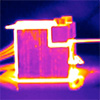| Jan 09, 2023 |
|
(Nanowerk News) Working with one of the world’s preeminent thermoelectric materials researchers, a team of researchers in the Clemson Department of Physics and Astronomy and the Clemson Nanomaterials Institute (CNI) has developed a new, fool-proof method to evaluate thermoelectric materials (Journal of Applied Physics, “Thermoelectric figure-of-merit from Peltier cooling”).
|
|
Department of Physics and Astronomy Research Assistant Professor Sriparna Bhattacharya, Engineer Herbert Behlow, and CNI Founding Director Apparao Rao collaborated with world-renowned researcher H. J. Goldsmid, professor emeritus at the University of New South Wales (UNSW) in Sydney, Australia, to create a one-stop method for evaluating the efficiency of thermoelectric materials.
|
|
Goldsmid is considered by many to be the “father of thermoelectrics” for his pioneering work in thermoelectric materials. Bhattacharya first connected with Goldsmid on LinkedIn, telling him she had confirmed one of his theoretical predictions during her graduate studies at Clemson University. Later, Bhattacharya shared a paper she wrote with Rao after she joined his research group. Goldsmid mentioned to her that he had a new method in mind for studying thermoelectrics and shared his one-page theory with her. He was 89 years old at the time and enthusiastically started collaborating with the CNI researchers because he considered Bhattacharya part of his own research “family.”
|
|
Thermoelectric materials use a temperature gradient (DT) to generate electricity. They can be used for power generation by converting heat to electricity (Seebeck method) or refrigeration by converting electricity to cooling (Peltier method). Thermoelectric materials are used in applications ranging from NASA space missions to seat warmers and coolers in vehicles.
|
|
The efficiency of thermoelectric materials is measured by a figure-of-merit, or zT, which considers the material’s temperature, electrical conductivity and thermal conductivity. The traditional method of determining zT requires two measurements using different sets of equipment, something that sometimes causes researchers to report incorrect results. In other words, researchers sometimes mistakenly measure electrical conductivity (charge flow) and thermal conductivity (heat flow) along different directions in their sample when it is switched from one instrument to the other.
|
|
Peltier cooling had not been used previously for evaluating zT because of a high DT , or the maximum achievable difference in temperature between the cold junction and ambient. “We used thermocouples containing a metal and a semiconductor junction to reduce the DT to a much narrower range so that the temperature dependent zT may be determined with a higher resolution,” Behlow said.
|
|
“The idea to use a metal and a semiconductor to reduce DT was hidden in plain sight until Professor Goldsmid recognized this was the case and proposed this new method for measuring zT,” Behlow added.
|
|
“The experimental setup we developed at CNI (with the help of the Department of Physics and Astronomy Instrument Shop) to test Professor Goldsmid’s theory ensures that the charge flow and the heat flow are measured in the same direction in the sample,” Rao said. “Therefore, by design, our method provides accurate zT.”
|

